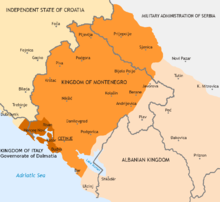This article has multiple issues. Please help improve it or discuss these issues on the talk page. (Learn how and when to remove these messages)
|
| Uprising in Montenegro | |||||||
|---|---|---|---|---|---|---|---|
| Part of World War II in Yugoslavia | |||||||
 The proposed Italian puppet Kingdom of Montenegro | |||||||
| |||||||
| Belligerents | |||||||
|
| |||||||
| Commanders and leaders | |||||||
| |||||||
| Units involved | |||||||
| Unknown |
| ||||||
| Strength | |||||||
| 32,000 people (Yugoslav sources)[3] |
| ||||||
| Casualties and losses | |||||||
|
5,000 killed 7,000 wounded (July)[5] | 1,079 killed or wounded[5] | ||||||
|
Civilian casualties:
| |||||||
The Uprising in Montenegro (Serbo-Croatian: Ustanak u Crnoj Gori / Устанак у Црној Гори), commonly known as the 13 July Uprising (Serbo-Croatian: Trinaestojulski ustanak / Тринаестојулски устанак) was an uprising against Italian occupation forces in Montenegro (Axis occupied Yugoslavia). Initiated by the Communist Party of Yugoslavia on 13 July 1941, it was suppressed within six weeks, but continued at a much lower intensity until Battle of Pljevlja on 1 December 1941. The insurgents were led by a combination of communists and former Royal Yugoslav Army officers from Montenegro. Some of the officers had recently been released from prisoner-of-war camps following their capture during the invasion of Yugoslavia. The communists managed the organisation and provided political commissars, while the insurgent military forces were led by former officers. The entire nation rejected the privileged position offered by its occupiers, rejected the capitulation in order to fight for Yugoslavia, together with "Russia" (the nationalist insurgents perceived the Soviet Union as Russia at the beginning of the uprising).[6]
Within three weeks of the start of the uprising, the insurgents managed to capture almost all the territory of Montenegro.[7][8] The Italian troops were forced to retreat to their strongholds in Pljevlja, Nikšić, Cetinje and Podgorica. The main insurgent commanders included the former officers Colonel Bajo Stanišić [clarification needed] and Major Đorđije Lašić,[clarification needed] with Captain Pavle Đurišić emerging as one of the principal leaders after he distinguished himself during the successful attack he led on Berane alongside communist forces.
The counter-offensive by more than 70,000 Italian troops, commanded by General Alessandro Pirzio Biroli, was assisted by Sandžak Muslim militia and Albanian irregular forces from border areas between Montenegro and Albania, and suppressed the uprising within six weeks. The former Royal Yugoslav Army officers and communists were in dispute over the insurgent's strategy. The nationalists wanted to protect the mountain villages if they were attacked. The communists disagreed and organized a frontal struggle against Italian forces in which the rebel forces were defeated. A split occurred between the insurgents because of their defeats, which were inflicted by the Italians, and because some of the insurgents realized that the uprising was led by the communists. Josip Broz Tito dismissed Milovan Đilas from the command of Partisan forces in Montenegro because of his mistakes during the uprising, particularly because Đilas chose a frontal struggle instead of guerrilla tactics against the Italian forces and because his "Leftist Errors". After the major defeat of 1 December 1941 during the unsuccessful attack of the communist forces on the Italian garrison in Pljevlja, many soldiers deserted Partisan forces and joined the anti-Communust Chetniks. Following this defeat, the communists terrorized the people they perceived as their enemies, which antagonized many in Montenegro.
The defeat of the communist forces during the Battle of Pljevlja, combined with the policy of terror they pursued, were the main reasons for the expansion of the conflict between the communist and nationalist insurgents in Montenegro following the uprising. In the second half of December 1941, nationalist military officers Đurišić and Lašić began a mobilization of armed units separate from the Partisans.
In early March 1942, Đurišić arranged one of the first collaboration agreements between the Italians and the Chetniks. This agreement was between Đurišić and Pirzio-Biroli, and related to the area of operations of the 19th Infantry Division Venezia. In May 1942, Đurišić attacked and defeated the last significant Partisan detachment in Montenegro. Based on agreements signed by the Italians with Đurišić and other Chetnik leaders, the Italian occupation in Montenegro was then effectively reduced to towns while Chetniks remained in control of the rest of the territory of Montenegro. In the second quarter of 1942, a joint Italian-Chetnik offensive resulted in the withdrawal of the remaining Partisan forces from Montenegro.
- ^ Djilas, Milovan (1980). Tito: the story from inside. Harcourt Brace Jovanovich. p. 183. ISBN 978-0-15-190474-7.
Mosa Pijade (1890–1957) Prominent Party theoretician of Serbian Jewish origin. With Djilas he led the Partisan uprising in Montenegro in 1941.
- ^ Božović, Branislav; Vavić, Milorad (1991). Surova vremena na Kosovu i Metohiji: kvislinzi i kolaboracija u drugom svetskom ratu. Institut za savremenu istoriju. p. 194. ISBN 978-8674030400.
- ^ Tomasevich 2001, p. 140.
- ^ Tomasevich 2001, p. 141.
- ^ a b Burgwyn 2005, p. 93: "In the July uprising some 5,000 Montenegrins died, 7,000 were wounded, and 10,000 deported to concentration camps. The Italians suffered a total of 1,079 dead and wounded."
- ^ Petranović 1992, p. 191, 192.
- ^ Klemenčič, Matjaž; Žagar, Mitja (2004). The Former Yugoslavia's Diverse Peoples: A Reference Sourcebook. ABC-CLIO. p. 176. ISBN 978-1-57607-294-3.
In a very short period of time almost all the territory of Montenegro (with exception of some important cities) fell into hands of the communists. But the communist made mistake and started to fight against their class enemy (i.e. members of the Montenegrin burgoise) which made them weaker. The Italians resumed their attacks and by the mid August 1941 had again enforced their control in Montenegro....Out of fear of the "red-terror," a significant percentage of Montenegrins started to cooperate with the Chetniks, who started to attack Partisans..... The Partisan movement strengthen again in Autumn.
- ^ Lampe 2000, p. 214a: "They quickly seized control of the upland majority of Montenegro"